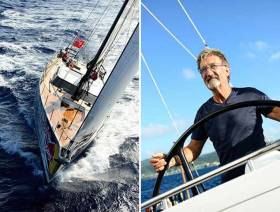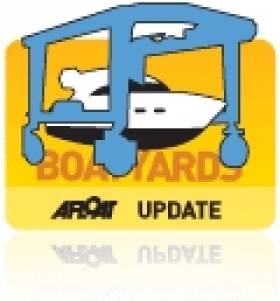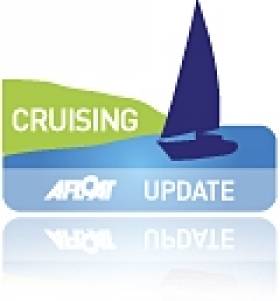Displaying items by tag: Eddie Jordan
Ireland’s Formula One Grand Prix legend Eddie Jordan has long been a keen sailor - his current vessel is the well-travelled Oyster 885 Lush. He has now stepped-up his involvement with the well-known UK-based firm as a result of its current re-structuring under the guidance of his longtime sailing friend Richard Hadida.
Richard Hadida has brought Eddie Jordan onto the board as Oyster Yachts – which works closely with international designer Rob Humphreys – re-shapes itself to re-hire most of its staff of 400 at locations in Southampton and Norfolk. The firm had 20 yachts across its renowned high-end range under construction when it went into administration last month, and now the intention is to continue to develop the new Oyster 118 while also taking a fresh look at the other end of the size spectrum, where it is reckoned there is a substantial market for a “super high-quality” 42 footer
Eddie Jordan's Superyacht Available To Charter
#Superyacht - Irish F1 supremo Eddie Jordan certainly pulled out all the stops when he caught the yachting bug, commissioning the largest recreational vessel ever built by luxury specialists Sunseeker.
And now his €40-million, 155-foot superyacht Blush, which was launched earlier this year, is available to charter over the winter months.
But as Motor Boat & Yachting reports, you'll need a sizeable bank balance to avail of this offer, as prices start at a whopping €200,000 for just seven days on board the luxury vessel.
More details from Sunseeker on Jordan's mansion-on-the-waves are available to read or download HERE.
Eddie Jordan's New 155–foot Sunseeker Super Yacht Nears Completion
#sunseeker – Is this the biggest boat owned by an Irishman? Sunseeker's largest ever yacht for Irish Formula One mogul Eddie Jordan has been revealed this weekend at Poole Quay in Dorset, the Bournemouth Echo reports.
The 155–foot yacht, reported to be worth £32 million, was painstakingly moved out of the shed by Sunseeker staff on Saturday and took more than an hour to move the short distance into the yard.
Eddie Jordan has been enjoying a lot of time on the ocean waves of late. Afloat previously reported (this time last year) on the start of Jordan's Round the World Rally. He was joined on that voyage by Dun Laoghaire sailing school instructor Paul Adamson on the Oyster 885, Lush, for the first ever Oyster World Rally.
Meanwhile in Poole, Stewart McIntyre, Managing Director at Sunseeker, whose Irish agents are MGM Boats in Dun Laoghaire, said yesterday: "This is an extremely exciting time for Sunseeker as we inch ever closer to the completion of the 155 Yacht.
"This is the biggest project we have ever undertaken and since the announcement of its build it has been the talk of the industry.
"We are incredibly proud of what we have created and look forward to showcasing it to the world."
The impressive accommodation can cater for 12 guests and 10 crew, and has an on board nightclub, a panoramic viewing area, a dining area, bar and its own garage for jet skis.
The largest luxury boat ever built by the company had to be moved using a radio controlled multiple wheeled unit from its build shed onto the quay at Poole for the final fitting out.
An extra radar mount was needed to complete the boat but it was far too tall for the current shed so the boat will have to spend at least one or two more weeks on the harbourside before it can be finally launched into the water.
More from the Bournemouth Echo here
Eddie Jordan's Yacht Heads off on Oyster World Rally
#oyster – Dun Laoghaire sailing school instructor Paul Adamson is on board with Eddie Jordan of Formula One fame, on the Oyster 885, Lush for the first ever Oyster World Rally.
After two years of planning, the rally started with a blast of cannon fire from Fort Charlotte, Antigua. The Georgian lookout post high above the 'Pillars of Hercules' was a perfect vantage point to watch the start of an adventure that will span a 16-month quest to sail around the world. There was tension on the dock before the start, when a vicious squall ripped through Nelson's Dockyard but undeterred, the Oyster fleet cast off lines and headed out to the starting area. Conditions at the start were nothing short of glorious; with 20 knots of warm Trade Winds and brilliant sunshine, the magnificent Oyster fleet was a spectacular sight, as they started the 27,000-mile adventure of a lifetime.
"It is such a proud moment." Enthused Oyster CEO, David Tydeman who was watching from the start line. "Today is the start of the first ever Oyster World Rally and a huge amount of effort has gone into making it happen. Watching the start was just so exhilarating but if I was being honest, I would say that I am extremely jealous; what a marvelous adventure to undertake and I am sure that the Oyster World Rally will capture the hearts and imagination of sailors the world over. It is every sailors dream to sail around the world and to witness the Oyster fleet departing today was a very special occasion for everyone associated with this event."
29 examples of the Oyster Range will take part in The Oyster World Rally. Each will have their own story to tell of the fantastic voyage. Eddie Jordan of Formula One fame, is sailing Oyster 885, Lush together with his wife, Marie. Eddie is a dab hand at the drums and gave an impromptu gig along with a sensational guitarist on the eve of the start. "It was great to wish everyone good luck last night with a bit of a dance and a sing along to a few anthems." Laughed Eddie . "This is going to be a fantastic experience, I have more air miles than you could imagine but to sail around the world is going to be the biggest adventure of them all. It is full of unknowns but that is all part of the attraction and I am just so thrilled about the whole thing."
After leaving Antigua, the Oyster World Rally heads for Panama with a rendezvous organised for all participants before entering the Panama Canal to cross into The Pacific Ocean. All of the yachts are fitted with Yellowbrick trackers throughout the 16-month Oyster World Rally.
Oyster World Rally Launches This Weekend
#Oyster - A fleet of 27 yachts from North America, South Africa and Western Europe - including Ireland - will take part in the 2013 Oyster World Rally, which sets off from Antigua in the West Indies tomorrow (6 January).
Celebrating the 40th anniversary of the sailing brand, the launch from Nelson's Dockyard will mark the start of a "16-month odyssey of endless adventure" that will take the fleet all the way round the world via more than 30 ports of call.
After passing through the Panama Canal and into the Pacific, the rally will stop at the the Galapagos Islands, Marquesas, Tahiti, Bora Bora and Moorea.
From there the fleet will head to the Great Barrier Reef, round the top of Australia, partying in Bali and heading west for Cape Town in time for next Christmas, then on to Brazil for next year's carnival, before joining up for a final grand party with the Oyster Caribbean Regatta in April 2014.
And the Irish will be in the thick of the action, via the Oyster 885 'Lush' owned by Formula 1 pundit and sailing convert Eddie Jordan.
Oyster World Rally event manager Debbie Johnson said: “It is very exciting to finally be in Antigua getting ready for the start.
"So many sailors dream of sailing around the world and the camaraderie throughout the fleet is just fantastic."
Follow the progress of the fleet as the rally gets under way via the official website HERE.
Eddie Jordan on the Podium in Grenada
Royal Cork's Stephen and Aileen Hyde's Oyster 56, A Lady, just missed out on a podium finish having just returned to the Caribbean following their 15 month circumnavigation.
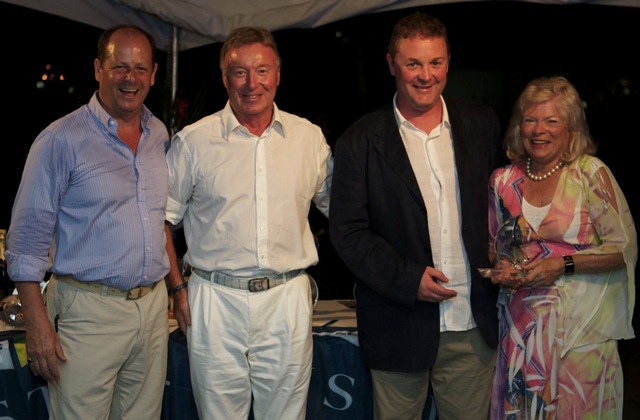
The happy smiling faces dockside at Port Louis were testament to a truly memorable Oyster Regatta on the magical island of Grenada. However there was an element of tension in the air, as Pantaenius Race Day was the last race to be sailed and a dramatic conclusion was to follow. The race area south west of Grenada was sublime, sunshine and crystal clear water with a warm breeze, which developed during the day, to a steady 12 knots.
Jonathan and Jane Mould's Oyster 72, Koluka continued their domination of Class One with their fourth victory, a clean sweep. An impressive performance but the couple did not come to Grenada just to compete, Jonathan and Jane were accompanied by their extended family, both daughters, husbands and grandchildren. "To be honest with you, the racing has been the most relaxing part. With three grandchildren all two or younger, it is a busy time ashore. My wife Jane has done most of the baby-sitting while I have gone sailing. It has been a lovely experience, it is always nice to do well but to be in such a wonderful place with my family that is something to savour for years to come."
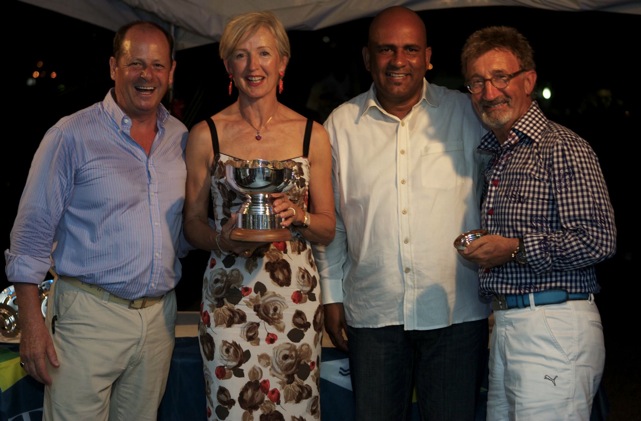
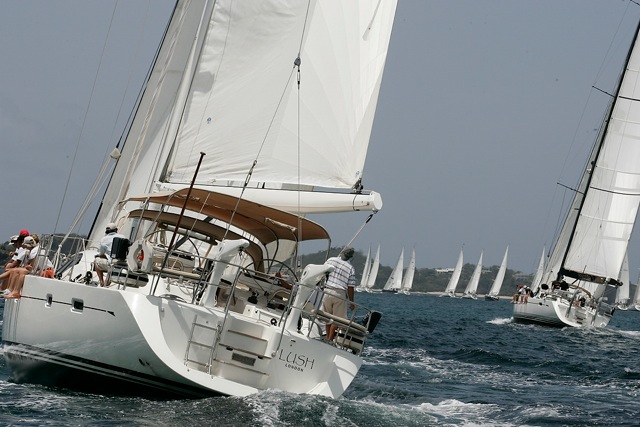
Chris and Susan Shea's Oyster 72, Magarathea was a gallant second, who scored consistently through the regatta. Eddie Jordan on board Oyster 655, Lush finished the regatta in style with their best result of the week, a close second to the overall winners Koluka.
Alan and Sue Brook's Oyster 56, Sulana were clear leaders this morning but a dramatic event on the racecourse nearly cost them victory. A coming together with John McTigue's Blue Dreams meant a 20 percent penalty, resulting a 10th place for Sulana for the final race. However, their string of wins prior to the last race meant that Sulana held on to the top spot to win Class Two.
Alan Brook commented: "We have been in Grenada for six weeks now and I can safely say it is an excellent place for many reasons and a very fitting venue for Oyster yachts and their owners, I have an excellent crew on Sulana who all worked well together to contribute to our success but I think that we can all leave Grenada as winners, it has been an excellent event."
Second in Class Two was Scott Bickford's American Oyster 56, Contingency. David Fass' Oyster 56, A Sulana was third by just a single point. Meaning that Ian Galbraith's Scottish Oyster 53, Jigsaw and Stephen and Aileen Hyde's Irish Oyster 56, A Lady, just missed out on a podium finish.
Stephen and Aileen Hyde left Crosshaven, in Southern Ireland in the summer of 2009 and haven't been back since. After cruising their Oyster 56 down to Las Palmas, they crossed the Atlantic and continued west with the World ARC fleet. Stephen has written fascinating account of their 30,000-mile circumnavigation, which is being published in Oyster News.
'Without doubt, the most amazing place we have visited was the San Blas Islands." Commented Stephen. "The archipelago is composed of approximately 200 islands off the coast of Panama. Beautiful beaches free from crocodiles and mosquitoes and brilliant diving in the reefs, crystal clear waters with an amazing variety of wildlife, even black tipped Reef Sharks, which would often swim with us. When I suggested to my wife that we should sail around the world, she said absolutely nothing – No comment. However with just a few days to go until the start, she told me she was coming and was going to sail every mile. It has been a fantastic adventure."
On the final night of the Oyster Regatta Grenada, the prize giving party was held at Port Louis Marina. The new facility has been a splendid setting for the Oyster fleet and a fitting venue for the closing ceremony and party. Over 230 guests attended the evening with Grenadian Minister of Tourism, Hon. Peter David, as Guest of Honour. "Sailing is very important to Grenada, it is deeply rooted in our culture and I speak for the Prime Minister and all Grenadians, that we were delighted to welcome all of the Oyster yachts to our island and hope that you all return soon." Commented Peter David
After the prize giving, a gourmet four-course meal was served, it was a very happy occasion with crews toasting each other and recalling memorable moments during a fantastic week. A brilliant firework display over the marina capped off a truly wonderful regatta. The Oyster Regatta in Grenada had been a roaring success. Probably one of the main reasons for that is the warmth and friendship of the people of Grenada, something that the Oyster family appreciates a great deal.
Photos: Oyster/Ingrid Abery
Eddie Jordan Racing...On Water
Irish F1analyst Eddie Jordan might be better known for exploits on tarmac than the high seas but it did not stop the 63-year old Dubliner sailing a smart race to win in the south-eastern Caribbean Sea today in day one of the Oyster Regatta writes Louay Habib. But the F1 man's powerful Oyster 655, Lush was pushed all the way by Chris Shea's Oyster 72, Magrathea.
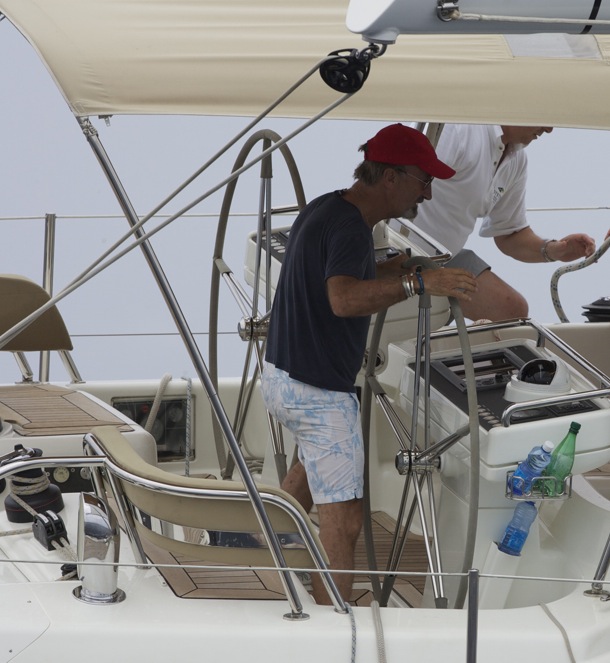
Eddie Jordan at the helm of the Oyster 655, Lush. Photo: Ingrid Abery
Grenada's lush, green paradise relies on rain and on the morning of Lewmar Race Day, the Oyster Fleet certainly got that. But despite the torrential downpour, the mood in Port Louis was up beat and all of the fleet left the dock, to perform a parade of sail, before heading out to the race area.
As if by magic, shortly after the start an easterly wind blew away the rain clouds. Providing dry, if somewhat tricky conditions. During the course of the day, there were numerous wind shifts, predicting these changes was the secret to success. A light airs start was followed by a building breeze, which piped up to fifteen knots by the end of the race.
Starts are always important but especially in fickle breeze and the Polish Oyster 46, SunsuSea, judged the line to perfection, to get away well. Owned by Mariusz and Paulina Kierebinscy, SunsuSea came to the Caribbean in the 2009 ARC.
"We have been really delighted with the boat." Smiled Mariusz. "My family love to sail, especially in the Caribbean. This is our second Oyster Regatta and although we have little experience with racing, it is a great way to learn how to improve our sailing technique."
Besides Mariusz and Paulina, SunsuSea is crewed by their family and friends. Daughter Claudia and son Martin are fast learners in the cockpit. Whilst friends, Artur and Margaret trim the mainsail, helped by their daughter Adriana, who is just 11 years of age.
"We really like Grenada." Continued Mariusz. 'It is such a friendly place and safe for our children. After the regatta, we will be cruising through The Grenadines to St. Lucia, our last adventure before the boat returns across the Atlantic."
In Class One, Lush, with F1 racing analyst, Eddie Jordan on board, sailed a smart race to win, but the powerful Oyster 655 was pushed all the way by Chris Shea's Oyster 72, Magrathea, who sailed a near perfect beat by using the lifting breeze, along Grande Anse Beach. Jonathon and Jane Mould's Oyster 72, Koluka claimed a well-deserved third in class.
Alan Brook, taking part in his first Oyster regatta as a competitor with his wife Sue in their Oyster 56, Sulana, won the first race in Class Two, the meticulously prepared yacht was extremely well positioned on the racecourse to win by a fair margin. Scott Bickford's American Oyster 53, Contingency was second and Ian Galbraith and crew, racing his Oyster 53, Jigsaw, kept their concentration to take third.
After the fleet had returned to the safe confines of Port Louis Marina, a cocktail party, hosted by the Marine and Yachting Association of Grenada, was full of talk about the day's events.
Later that evening, the Oyster family was treated to a lavish party at the exclusive LaLuna Estate. Tucked away south of the capital, LaLuna is the hidden gem of Morne Rouge Bay, which offers one of the finest beaches on the island, just minutes from St George's. The estate is often frequented by stars of the stage and film and provided a truly magical occasion for the second Oyster party of the regatta.
The ultra-chic secluded venue has a rustic charm extenuated by the use of traditional Caribbean materials to provide a design-fusion, which is unmistakably Asian in appearance. The wooden beachfront courtyard blends cane, cotton, and thatch and inviting day beds are scattered throughout the resort with sublime views of the perfect beach.
The Oyster family enjoyed a mouth watering four-course dinner with fine wine in a wonderful atmosphere. Afterwards, a company of dancers electrified the atmosphere and very soon the party was a very lively affair. It may have been a day of mixed fortunes on the water but the Oyster crew-conga, snaking through the LaLuna's courtyard, was testament to a very successful first day's racing at the Oyster Regatta in Grenada.
Racing resumes on Wednesday 13th April with a coastal race sponsored by Pelagos Yachts, finishing at Le Phare Bleu Marina, on the south coast of Grenada, where the fleet will overnight.


























